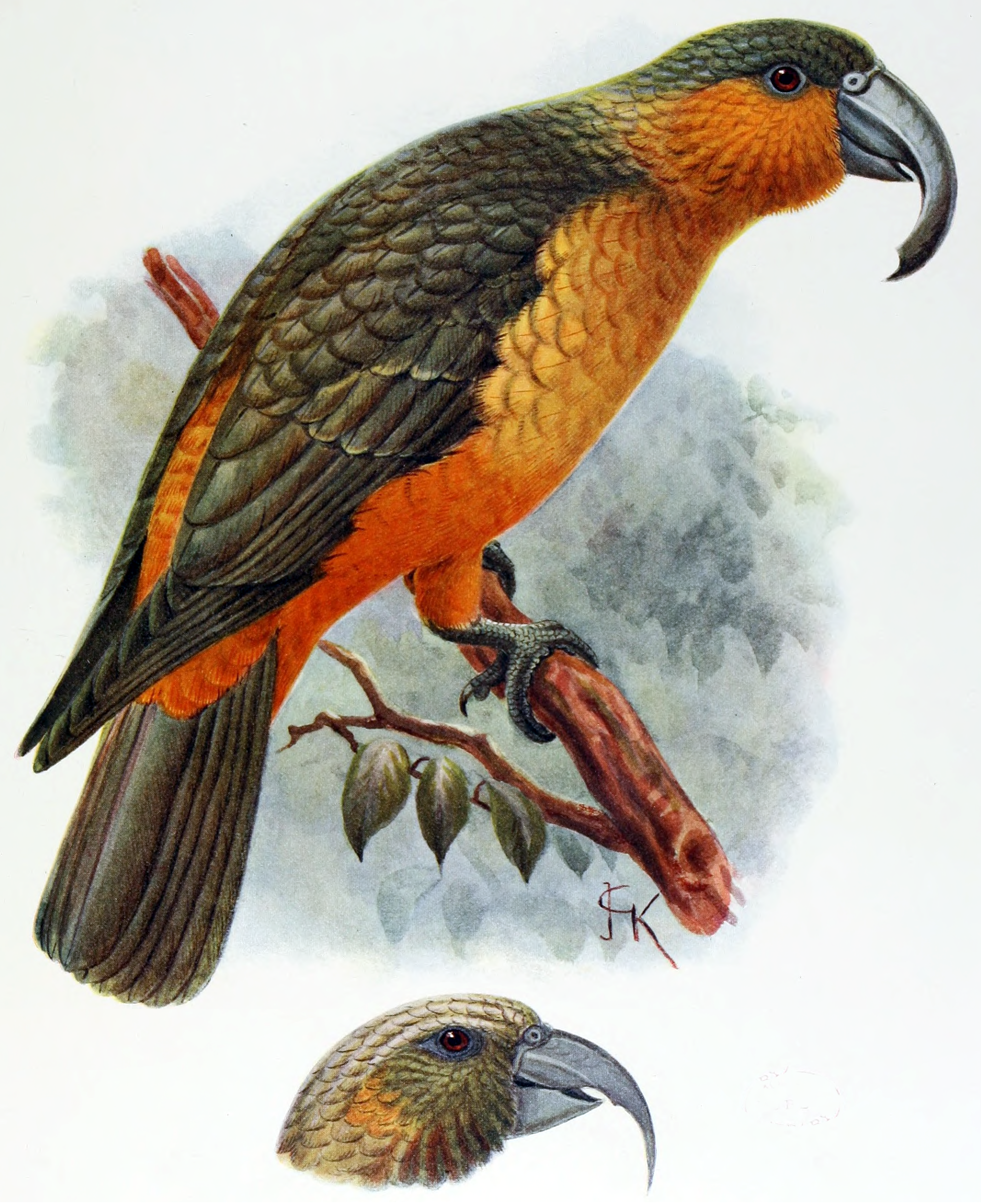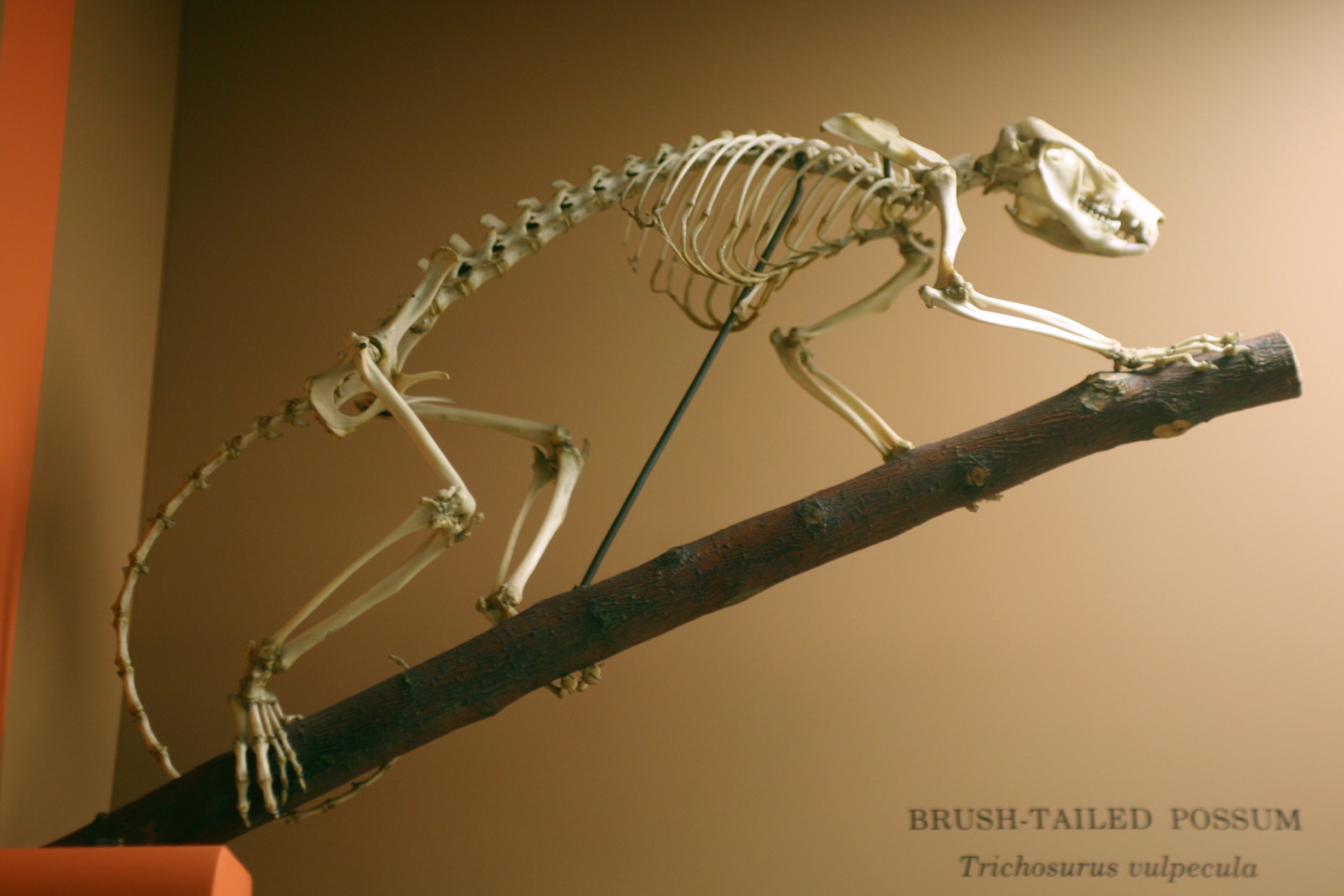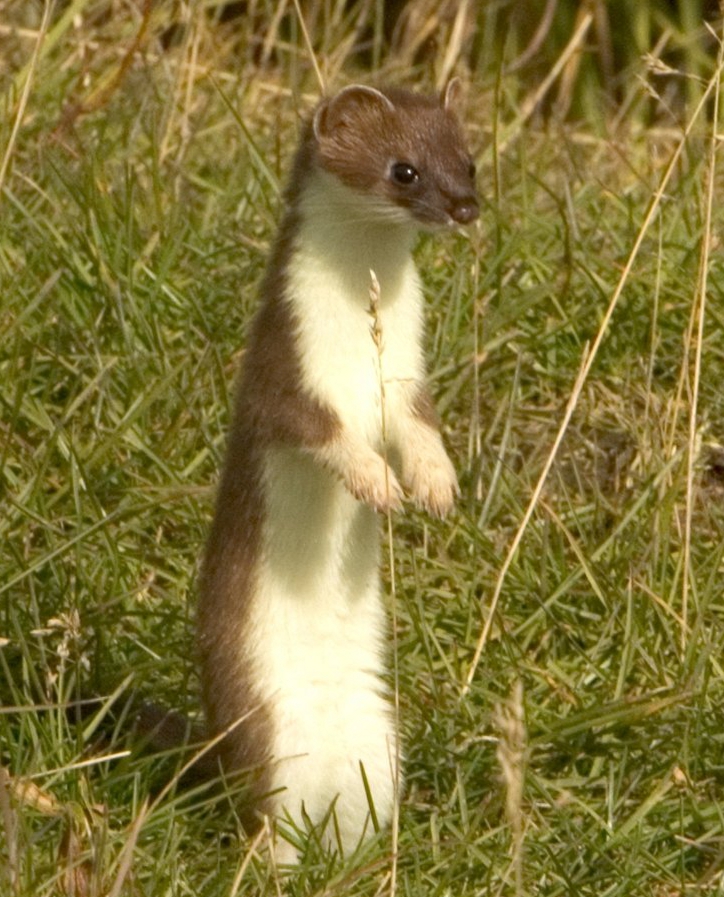|
Nestoridae
The New Zealand parrot family, Strigopidae,Nestoridae and Strigopidae are described in the same article, Bonaparte, C.L. (1849) ''Conspectus Systematis Ornithologiae''. Therefore, under rules of the ICZN, the first reviser determines priority, which is Bonaparte, C.L. (1850), ''Conspectus Generum Avium'', E.J. Brill, Leyden. consists of at least three genera of parrots – '' Nestor'', '' Strigops'', the fossil '' Nelepsittacus'', and probably the fossil ''Heracles''. The genus ''Nestor'' consists of the kea, kākā, Norfolk kākā and Chatham kākā, while the genus ''Strigops'' contains the iconic kākāpō. All extant species are endemic to New Zealand. The species of the genus ''Nelepsittacus'' were endemics of the main islands, while the two extinct species of the genus ''Nestor'' were found at the nearby oceanic islands such as Chatham Island of New Zealand, and Norfolk Island and adjacent Phillip Island. The Norfolk kākā and the Chatham kākā have become extinct ... [...More Info...] [...Related Items...] OR: [Wikipedia] [Google] [Baidu] |
Nestor (genus)
The genus ''Nestor'' is one of the two extant taxon, extant genera of the parrot family New Zealand parrot, Strigopidae. Together with the kākāpō, and the extinct parrots in the genus ''Nelepsittacus'', they form the parrot superfamily Strigopoidea. The ''Nestor's'' genus contains two Extant taxon, extant parrot species from New Zealand and two extinct species from Norfolk Island, Australia and Chatham Island, New Zealand, respectively. All species are large stocky birds with short squarish tails. A defining characteristic of the genus is the tongue, which is tipped with a hair-like fringe. The superficial resemblance of this tongue to that of lorikeets has led some taxonomists to consider the two groups closely related, but DNA evidence shows they are not. Classification All four species in the genus ''Nestor'' are thought to stem from a 'proto-kaka', dwelling in the forests of New Zealand 5 million years ago. The closest living relative of the genus is the kākāpō (''Strigo ... [...More Info...] [...Related Items...] OR: [Wikipedia] [Google] [Baidu] |
Chatham Kākā
The Chatham kākā or Chatham Island kākā (''Nestor chathamensis'') is an extinct parrot species previously found on the Chatham Islands, New Zealand. The first individuals were thought to belong to the New Zealand kākā (''Nestor meridionalis''), but detailed examination of the subfossil bones showed that they actually belong to a separate endemic species. The species became extinct within the first 150 years of the arrival of the Polynesians around 1500, long before any European settlers. No skins or descriptions are available. Taxonomy The Chatham kākā is assigned to the genus ''Nestor'' in the family Nestoridae, a small group of parrot species native to New Zealand. It is considered to have been more closely related to the kākā (''Nestor meridionalis'') and the extinct Norfolk kākā (''Nestor productus'') than to the kea (''Nestor notabilis''). Ecology The Chatham kākā was a forest dwelling species of about the same size as the North Island subspecies of the kākā ... [...More Info...] [...Related Items...] OR: [Wikipedia] [Google] [Baidu] |
Norfolk Kākā
The Norfolk kākā (''Nestor productus'') is an extinct species of large parrot, belonging to the parrot family Nestoridae. The birds were about 38 cm long, with mostly olive-brown upperparts, reddish-orange cheeks and throat, straw-coloured breast, thighs, rump and lower abdomen dark orange and a prominent beak. It inhabited the rocks and treetops of Norfolk Island and adjacent Phillip Island. It was a relative of the New Zealand kākā. Taxonomy The Norfolk kākā was first described by the naturalist Johann Reinhold Forster and his son Georg following the discovery of Norfolk Island by James Cook on 10 October 1774. The description was only published in 1844. Around 1790, John Hunter depicted a bird on a kangaroo apple (''Solanum aviculare''). The bird was formally described by John Gould in 1836, from a specimen at the Zoological Society of London. Originally, the individuals from Norfolk Island and Philip Island were considered two separate species, ''Nestor norfo ... [...More Info...] [...Related Items...] OR: [Wikipedia] [Google] [Baidu] |
Nelepsittacus
''Nelepsittacus'' is a genus of extinct New Zealand parrots that is closely related to the genus '' Nestor'' (the living kākā and kea). It consists of four species, of which three have been named so far. The species are all known from the early Miocene Saint Bathans Fauna from the Lower Bannockburn Formation in Otago in New Zealand. Features in their skeletons, namely the coracoid, humerus, tibiotarsus, and tarsometatarsus, that they share only with the ''Nestor'' parrots link them to that genus.Leo Joseph, Alicia Toon, Erin E. Schirtzinger, Timothy F. Wright & Richard Schodde. (2012) A revised nomenclature and classification for family-group taxa of parrots (Psittaciformes). Zootaxa 3205: 26–40 Flora from the Saint Bathans fauna fossil beds indicate these parrots were found in a subtropical rainforest habitat. Following the early to mid Miocene, there was a drop in temperature, which led to a loss of local flora and fauna. This loss of native ''Nelepsittacus'' parrots li ... [...More Info...] [...Related Items...] OR: [Wikipedia] [Google] [Baidu] |
Parrot
Parrots (Psittaciformes), also known as psittacines (), are birds with a strong curved beak, upright stance, and clawed feet. They are classified in four families that contain roughly 410 species in 101 genus (biology), genera, found mostly in tropics, tropical and subtropics, subtropical regions. The four families are the Psittaculidae (Old World parrots), Psittacidae (African and New World parrots), Cacatuidae (cockatoos), and Strigopidae (New Zealand parrots). One-third of all parrot species are threatened by extinction, with a higher aggregate extinction risk (Red List Index, IUCN Red List Index) than any other comparable bird group. Parrots have a generally pantropical distribution with several species inhabiting temperateness, temperate regions as well. The greatest biodiversity, diversity of parrots is in South America and Australasia. Parrotsalong with Corvidae, ravens, crows, jays, and magpiesare among the most #Intelligence and learning, intelligent birds, and the abil ... [...More Info...] [...Related Items...] OR: [Wikipedia] [Google] [Baidu] |
Early Miocene
The Early Miocene (also known as Lower Miocene) is a sub-epoch of the Miocene epoch (geology), Epoch made up of two faunal stage, stages: the Aquitanian age, Aquitanian and Burdigalian stages. The sub-epoch lasted from 23.03 ± 0.05 annum, Ma to 15.97 ± 0.05 Ma (million years ago). It was preceded by the Oligocene epoch. As the climate started to get cooler, the landscape started to change. New mammals evolved to replace the extinct animals of the Oligocene epoch. The first members of the hyena and weasel family started to evolve to replace the extinct ''Hyaenodon'', entelodonts and bear-dogs. The chalicotheres survived the Oligocene epoch. A new genus of entelodont called ''Daeodon'' evolved in order to adapt to the new habitats and hunt the new prey animals of the Early Miocene epoch; it quickly became the top predator of North America. But it became extinct due to competition from ''Amphicyon'', a newcomer from Eurasia. ''Amphicyon'' bested ''Daeodon'' because the bear-dog's la ... [...More Info...] [...Related Items...] OR: [Wikipedia] [Google] [Baidu] |
Common Brushtail Possum
The common brushtail possum (''Trichosurus vulpecula'', from the Ancient Greek, Greek for "furry tailed" and the Latin for "little fox", previously in the genus ''Phalangista'') is a nocturnal, semiarboreal marsupial of the family Phalangeridae, native to Australia and Invasive species, invasive in New Zealand, and the second-largest of the Phalangeriformes, possums. Like most possums, the common brushtail possum is nocturnal. It is mainly a folivore, but has been known to eat small mammals such as rats. In most Australian habitats, eucalyptus leaves are a significant part of the diet, but rarely the sole item eaten. Its tail is Prehensile tail, prehensile and naked on its lower underside. The four colour variations are silver-grey, brown, black, and gold. It is the Australian marsupial most often seen by city dwellers, as it is one of few that thrive in cities and a wide range of natural and human-modified environments. Around human habitations, common brushtails are inventive ... [...More Info...] [...Related Items...] OR: [Wikipedia] [Google] [Baidu] |
Invasive Species In New Zealand
A number of introduced species, some of which have become invasive species, have been added to New Zealand's native flora and fauna. Both deliberate and accidental introductions have been made from the time of the first human settlement, with several waves of Polynesian people at some time before the year 1300, followed by Europeans after 1769. Almost without exception, the introduced species have been detrimental to the native flora and fauna, but some, such as farmed sheep and cows and the clover upon which they feed, now form a large part of the economy of New Zealand. Possibility of introduced herbivores ( deer) to serve as ecological proxies for extinct moa has been questioned. Biosecurity New Zealand maintains registers and lists of species that are invasive, potentially invasive, or a threat to agriculture or biodiversity. They also manage a small number of species under the National Interest Pest Responses (NIPR) programme. The rainbow lorikeet is the one anima ... [...More Info...] [...Related Items...] OR: [Wikipedia] [Google] [Baidu] |
Weasel
Weasels are mammals of the genus ''Mustela'' of the family Mustelidae. The genus ''Mustela'' includes the least weasels, polecats, stoats, ferrets, and European mink. Members of this genus are small, active predators, with long and slender bodies and short legs. The family Mustelidae, or mustelids (which also includes badgers, otters, and wolverines), is often referred to as the "weasel family". In the UK, the term "weasel" usually refers to the smallest species, the least weasel (''M. nivalis''), the smallest carnivoran species. Least weasels vary in length from , females being smaller than the males, and usually have red or brown upper coats and white bellies; some populations of some species moult to a wholly white coat in winter. They have long, slender bodies, which enable them to follow their prey into burrows. Their tails may be from long. Weasels feed on small mammals and have from time to time been considered vermin because some species took poultry fr ... [...More Info...] [...Related Items...] OR: [Wikipedia] [Google] [Baidu] |
Wasp
A wasp is any insect of the narrow-waisted suborder Apocrita of the order Hymenoptera which is neither a bee nor an ant; this excludes the broad-waisted sawflies (Symphyta), which look somewhat like wasps, but are in a separate suborder. The wasps do not constitute a clade, a complete natural group with a single ancestor, as bees and ants are deeply nested within the wasps, having evolved from wasp ancestors. Wasps that are members of the clade Aculeata can sting their prey. The most commonly known wasps, such as yellowjackets and hornets, are in the family Vespidae and are eusocial, living together in a nest with an egg-laying queen and non-reproducing workers. Eusociality is favoured by the unusual haplodiploid system of sex determination in Hymenoptera, as it makes sisters exceptionally closely related to each other. However, the majority of wasp species are solitary, with each adult female living and breeding independently. Females typically have an oviposit ... [...More Info...] [...Related Items...] OR: [Wikipedia] [Google] [Baidu] |
Habitat Loss
Habitat destruction (also termed habitat loss or habitat reduction) occurs when a natural habitat is no longer able to support its native species. The organisms once living there have either moved elsewhere, or are dead, leading to a decrease in biodiversity and Abundance (ecology), species numbers. Habitat destruction is in fact the leading cause of biodiversity loss and species extinction worldwide. Humans contribute to habitat destruction through the Exploitation of natural resources, use of natural resources, agriculture, industrial production and urbanization (urban sprawl). Other activities include mining, logging and trawling. Environmental factors can contribute to habitat destruction more indirectly. Geological processes, climate change, introduced species, introduction of invasive species, ecosystem nutrient depletion, water pollution, water and noise pollution are some examples. Loss of habitat can be preceded by an initial habitat fragmentation. Fragmentation and lo ... [...More Info...] [...Related Items...] OR: [Wikipedia] [Google] [Baidu] |
Norfolk Island
Norfolk Island ( , ; ) is an States and territories of Australia, external territory of Australia located in the Pacific Ocean between New Zealand and New Caledonia, directly east of Australia's Evans Head, New South Wales, Evans Head and about from Lord Howe Island. Together with the neighbouring Phillip Island (Norfolk Island), Phillip Island and Nepean Island (Norfolk Island), Nepean Island, the three islands collectively form the Territory of Norfolk Island. At the 2021 Australian census, 2021 census, it had 2,188 inhabitants living on a total area of about . Its capital is Kingston, Norfolk Island, Kingston. East Polynesians were the first to settle Norfolk Island, but they had already departed when Kingdom of Great Britain, Great Britain settled it as part of its 1788 colonisation of Australia. The island served as a penal colony, convict penal settlement from 6 March 1788 until 5 May 1855, except for an 11-year hiatus between 15 February 1814 and 6 June 1825, when ... [...More Info...] [...Related Items...] OR: [Wikipedia] [Google] [Baidu] |







